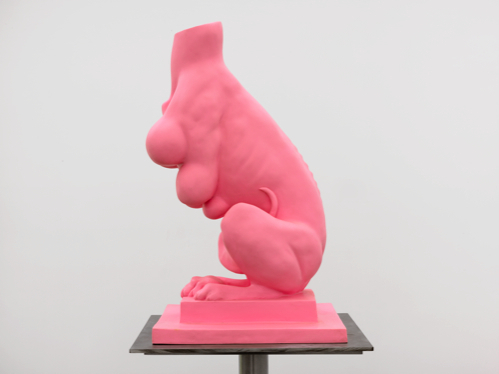Wandering through the colorfully gay labyrinths of 798 – by far, the foremost art district in Beijing – on a chilly January afternoon, I stumble onto a grey building, quite out of sync with its neighboring galleries and museums that shine in colourful resplendence. This, however, is it– my pilgrim spot – the Faurschou Foundation, Beijing. Inside its grim and non-glamorous exterior, it is housing an exhibition of Louise Bourgeois’s works – for the first time in China, curated by the artist’s long-time partner Jerry Gorovoy. Stepping inside the premises to witness Bourgeois’s art from up close and so personal was thus nothing short of the experience of entering a temple for me. It was the moment of self-gratification. This piece is therefore not – and cannot be – a review, in the strictest sense. It may at best be read as an ode by a star-struck aficionada.
There it was – in the very first room – the giant Crouching Spider (2003) made out of steel. It literally took my breath away as I stood gazing at its enormity and the intricacies of its details, which could have come only from somebody who deeply empathised with the otherwise-insignificant creature, and found reflections of her ‘mamman’– mother – in it, by virtue of its industriousness, tolerance, patience and protective nature.

Louise Bourgeois, THE COUPLE, 2003; Photo by Jonathan Leijonhufvud, + Louise Bourgeois Trust/ Licensed by VAGA, NY#5385.
I really had to see it to believe it, to feel the tactility in her sculptures. I was left speechless thereafter, as I stared at the suspended aluminum Couple (2003). The malleable fluidity achieved out of sheer concrete could have been the handiwork of someone who had poured out the entirety of her very existence – complete with its pain, trauma and distress – into the making of this exquisitely moving work of art. Shapes and sizes conforming to social dictates become redundant, as the two bodies that entwine to form the couple contort and distort individually and together to form a third enmeshed identity that is more spiritual than physical. It is, as Gorovoy writes, one of the many visual articulations of Bourgeois’s sense of intense loneliness, insecurity and the consequent need for desperate clinging on to all that she held dear to her; the fear of loss dripping from every ounce of her creations. For her thus “hell” was not Sartre’s “others”: it was in fact, the very “absence of others.”
Years of childhood trauma stemming from multiple sources, most of which remain unknown – thereby bringing in that aura of enigma in her works – reveal themselves most poignantly in her depictions of the female body (Nature Study [1984], Pregnant Woman [2003], In and Out [1995]). Even though her chosen colour to depict femininity remains pink or red, her mediums vacillate between hard as marble and soft as cloth; and they enthrall not only in the details of their tininess, but more deeply, in their primal quality – that frees them from the confines of just the human soul, fusing a oneness with the larger living world.

Louise Bourgeois, NATURE STUDY, 1984, cast 2000; Photo by Jonathan Leijonhufvud, + Louise Bourgeois Trust/Licensed by VAGA, NY#750D.
A life as complex and rigged with turbulence as Bourgeois’s could have frittered itself away and passed into oblivion like that of so many others. We are a lucky lot, a blessed lot, who can witness the outcome of such unabated trauma as it flowered into the most potent visual articulations; filling us – distanced from her in time, space and culture – with an empathy that can perhaps emanate only from art, that has sometimes been used as catharsis, sometimes as language and mostly as palliative – if not cure.
(Image on top: Louise Bourgeois, CROUCHING SPIDER , 2003; Photo by Jonathan Leijonhufvud + Louise Bourgeois Trust/ Licensed by VAGA, NY#5385.)